Hello,
pleased to see such amazing planetary pictures and trying to improve mines.
i have a C11 and recently adquired a zwo 462mc camera and taking my first steps. Previously taking pictures with flip mirror, philips toucam pro and televue barlow x2. Good results but trying to improve, After many attemps with firecapture, SC11, Zwo 462mc with Baader IR cut filter and barlow x2 with Moon, Mars, Jupiter and Saturn and with astrostakkert and registax, blurry results. I tried with debayered videos and non debayered videos from firecapture, same results. Using barlow x2 is too much magnification? . The zoom in firecapture is affecting to quality record or it is only to see the image details better in the screen of the pc?.
Thank you for your help.
|
You cannot like this item. Reason: "ANONYMOUS".
You cannot remove your like from this item.
Editing a post is only allowed within 24 hours after creating it.
You cannot Like this post because the topic is closed.
Copy the URL below to share a direct link to this post.
This post cannot be edited using the classic forums editor.
To edit this post, please enable the "New forums experience" in your settings.
Collimation and seeing are critical to operate a large aperture at such a high image scale. I'd suggest you try your hand first without the barlow (using the ASI camera you basically doubled the image scale already) and see how things go. Normally I look how the planet look like with an EP and high resolution (at least 300x) before committing time to acquisition. If the seeing is crap I won't waste my time.
As far as I remember firecapture zoom does not change the captured .ser file resolution (which is set by the camera controls).
|
You cannot like this item. Reason: "ANONYMOUS".
You cannot remove your like from this item.
Editing a post is only allowed within 24 hours after creating it.
You cannot Like this post because the topic is closed.
Copy the URL below to share a direct link to this post.
This post cannot be edited using the classic forums editor.
To edit this post, please enable the "New forums experience" in your settings.
Thank you very much indeed. I will try without barlow and check collimation. It is true that the seeing was not very good and as you explain, with the toucam this issue could have been less relevant. Thanks again
|
You cannot like this item. Reason: "ANONYMOUS".
You cannot remove your like from this item.
Editing a post is only allowed within 24 hours after creating it.
You cannot Like this post because the topic is closed.
Copy the URL below to share a direct link to this post.
This post cannot be edited using the classic forums editor.
To edit this post, please enable the "New forums experience" in your settings.
andrea tasselli:
Collimation and seeing are critical to operate a large aperture at such a high image scale. I'd suggest you try your hand first without the barlow (using the ASI camera you basically doubled the image scale already) and see how things go. Normally I look how the planet look like with an EP and high resolution (at least 300x) before committing time to acquisition. If the seeing is crap I won't waste my time.
As far as I remember firecapture zoom does not change the captured .ser file resolution (which is set by the camera controls). andrea tasselli:
Collimation and seeing are critical to operate a large aperture at such a high image scale. I'd suggest you try your hand first without the barlow (using the ASI camera you basically doubled the image scale already) and see how things go. Normally I look how the planet look like with an EP and high resolution (at least 300x) before committing time to acquisition. If the seeing is crap I won't waste my time.
As far as I remember firecapture zoom does not change the captured .ser file resolution (which is set by the camera controls). *Hello Andrea, last night I tested without barlow and very good results with Saturn and Jupiter. One example here not fully optimized. Thank you very much indeed. # 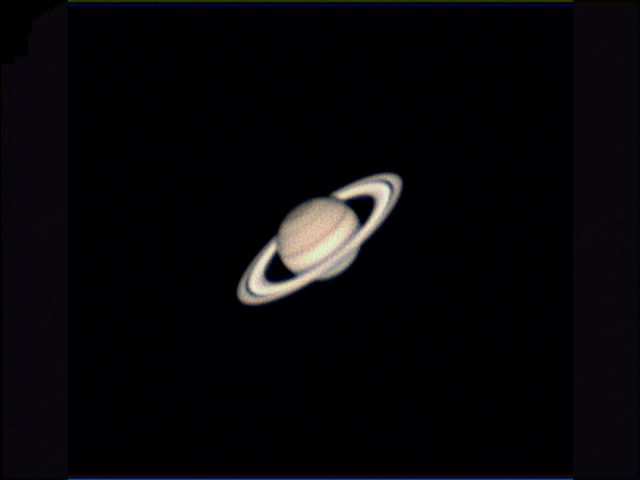 |
You cannot like this item. Reason: "ANONYMOUS".
You cannot remove your like from this item.
Editing a post is only allowed within 24 hours after creating it.
You cannot Like this post because the topic is closed.
Copy the URL below to share a direct link to this post.
This post cannot be edited using the classic forums editor.
To edit this post, please enable the "New forums experience" in your settings.
Dear all, I did the collimation of my C11 and I have been trying to improve my images ( no barlow) and after several weeks with my new zwo 462mc and different seeings, I am afraid I am doing something wrong. Below you can see the results after astrostakkert ( Laplace 5, double stack reference, 55% of images, normalize stack 75, sharpened 25%, no RGB align, no close to edge, no multiscale ) from a video with these parameters: Location: Galapagar ( 36 kms from Madrid) Spain Camera=ZWO ASI462MC Filter=L Profile=saturn 2 Diameter=49.05" Magnitude=-2.87 CMI=88.5° CMII=241.2° CMIII=65.2° (during mid of capture) FocalLength=1700mm Resolution=0.35" Filename=saturn 2_013826_Gain=291(off)_Exposure=10.0ms_Gamma=51_220821.ser Date=220821 Start=013754.145 Mid=013826.852 End=013859.559 Start(UT)=233754.145 Mid(UT)=233826.852 End(UT)=233859.559 Duration=65.414s Date_format=ddMMyy Time_format=HHmmss LT=UT +1h Frames captured=6533 File type=SER Binning=no ROI=600x400 ROI(Offset)=0x0 FPS (avg.)=99 Shutter=10.00ms Gain=291 (48%) WBlue=92 (off) WRed=63 (off) AutoGain=off AutoHisto=75 (off) HighSpeed=off AutoExposure=off Gamma=51 Brightness=0 (off) FPS=407 (off) USBTraffic=100 (off) SoftwareGain=10 (off) Histogramm(min)=0 Histogramm(max)=184 Histogramm=72% Noise(avg.deviation)=n/a Limit=none Sensor temperature=31.4°C These are the two images that astrostackkert gives as results: # 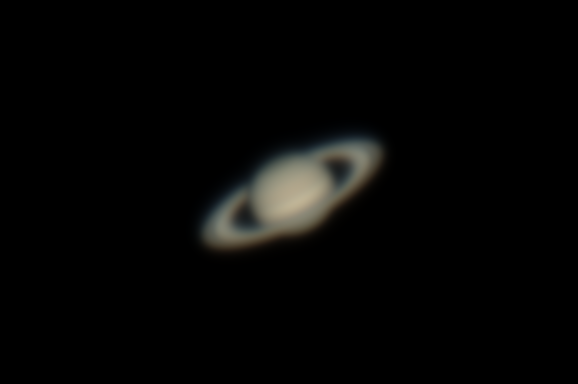 #  Please, what am I doing wrong? Thank you very much indeed in advance.
|
You cannot like this item. Reason: "ANONYMOUS".
You cannot remove your like from this item.
Editing a post is only allowed within 24 hours after creating it.
You cannot Like this post because the topic is closed.
Copy the URL below to share a direct link to this post.
This post cannot be edited using the classic forums editor.
To edit this post, please enable the "New forums experience" in your settings.
I suspect seeing is the issue there. And there is no way you can improve upon that. I suggest you take a short video of a bright star, in focus, to see what kind of seeing you have and maybe report back.
|
You cannot like this item. Reason: "ANONYMOUS".
You cannot remove your like from this item.
Editing a post is only allowed within 24 hours after creating it.
You cannot Like this post because the topic is closed.
Copy the URL below to share a direct link to this post.
This post cannot be edited using the classic forums editor.
To edit this post, please enable the "New forums experience" in your settings.
Hello jcac68, The 462MC is a fine camera and your settings are looking good. This the best result I can process with your AS!3 output (unsharpened) using Registax6 wavelets and Photoshop: 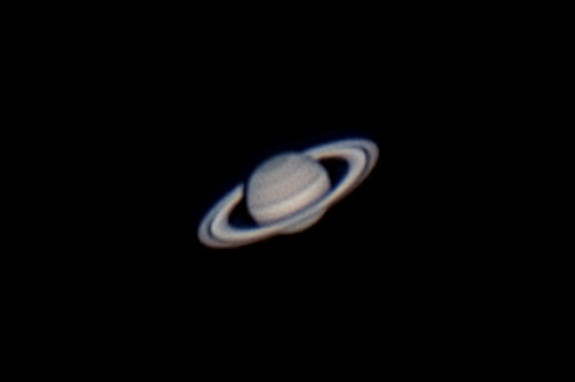 Thin clouds or haze in addition to poor seeing is the likely cause. Large scopes do not only gather more light but also more turbulences. When seeing is poor stacking 55% can be too much. I usually go for 10 to 20%. Cheers, Robert
|
You cannot like this item. Reason: "ANONYMOUS".
You cannot remove your like from this item.
Editing a post is only allowed within 24 hours after creating it.
You cannot Like this post because the topic is closed.
Copy the URL below to share a direct link to this post.
This post cannot be edited using the classic forums editor.
To edit this post, please enable the "New forums experience" in your settings.
One thing I love about the camera is that it quickly plugs in as a 1.25" eyepiece basically, so I can have a visual session and plop in the camera to capture 2min data. It's done well on the Moon for me with the Astronomik ProPlanet 804 IR-pass filter - leaving my improvement focus in other areas: 
Waxing Crescent Moon - March 21, 2021But I'm bad with planets so far. Here's some data I took recently with a 810mm doublet, same camera - any advice for cleaning this up in the future? Part of the issue may just be focal length and seeing - so perhaps different issues than OP. However, as I've not used Registax6 - @astropical what process do you run the AS!3 data through in Registax6, and how much PS work do you typically apply? That Saturn above is a lot clearer than my first shot turned out: 
Saturn at Opposition, Aug 2, 2021And also recently, of Jupiter: 
Jupiter and moons, Aug 22, 2021Anyway - same camera here too so I'm curious to get some tips. Recent settings for that Jupiter shot from Sharpcap. Outputs into AS!3, then went to sharpening and PS work: [ZWO ASI462MC] Debayer Preview=On Pan=696 Tilt=274 Output Format=SER file (*.ser) Binning=1 Capture Area=544x548 Colour Space=RAW16 Temperature=27 High Speed Mode=On Turbo USB=100(Auto) Flip=None Frame Rate Limit=Maximum Gain=425 Exposure=0.000192 Timestamp Frames=On White Bal (B)=81 White Bal (R)=46 Brightness=52 Auto Exp Max Gain=300 Auto Exp Max Exp M S=30000 Auto Exp Target Brightness=100 Mono Bin=Off Banding Threshold=35 Banding Suppression=0 Apply Flat=None Subtract Dark=None #Black Point Display Black Point=0 #MidTone Point Display MidTone Point=0.5 #White Point Display White Point=1 Notes= TimeStamp=2021-08-23T04:04:08.8068287Z SharpCapVersion=3.2.6480.0
|
You cannot like this item. Reason: "ANONYMOUS".
You cannot remove your like from this item.
Editing a post is only allowed within 24 hours after creating it.
You cannot Like this post because the topic is closed.
Copy the URL below to share a direct link to this post.
This post cannot be edited using the classic forums editor.
To edit this post, please enable the "New forums experience" in your settings.
Hello jcac68,
The 462MC is a fine camera and your settings are looking good.
This the best result I can process with your AS!3 output (unsharpened) using Registax6 wavelets and Photoshop:

Thin clouds or haze in addition to poor seeing is the likely cause.
Large scopes do not only gather more light but also more turbulences.
When seeing is poor stacking 55% can be too much. I usually go for 10 to 20%.
Cheers,
Robert * Hello @astropical , thank you very much indeed for your helpful advices. The quality of your processed image is similar to mines so I agree with you this is not the issue but the video. By now I am not using my televue barlow x2 that I used with my old phillips toucam pro because I am afraid that is such magnification that any seeing issue will be a huge problem. With this pixel size and focal lenght , is it neccesary to use bining with or without barlow? here another example of Copernicus after processing with astrostakkert and registax # 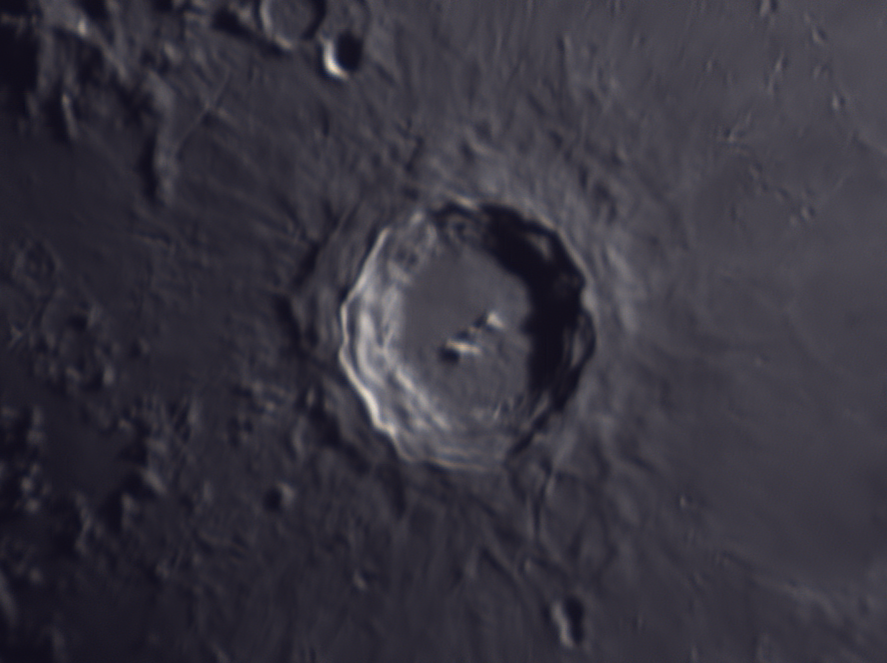 Thank you very much. Cheers
|
You cannot like this item. Reason: "ANONYMOUS".
You cannot remove your like from this item.
Editing a post is only allowed within 24 hours after creating it.
You cannot Like this post because the topic is closed.
Copy the URL below to share a direct link to this post.
This post cannot be edited using the classic forums editor.
To edit this post, please enable the "New forums experience" in your settings.
andrea tasselli:
I suspect seeing is the issue there. And there is no way you can improve upon that. I suggest you take a short video of a bright star, in focus, to see what kind of seeing you have and maybe report back. *thank you very much indeed Andrea. Cheers
|
You cannot like this item. Reason: "ANONYMOUS".
You cannot remove your like from this item.
Editing a post is only allowed within 24 hours after creating it.
You cannot Like this post because the topic is closed.
Copy the URL below to share a direct link to this post.
This post cannot be edited using the classic forums editor.
To edit this post, please enable the "New forums experience" in your settings.
Hello @jcac68,
The focal length of your C11 is long enough for nice close-up views of the lunar surface, in that I recommend to make the first steps without a barlow (no binning for the time being).
My rule of thumb regarding pixel resolution is 5 x camera pixel size, hence 5 x 2.9 ≈f15. Therefore, I almost always use a 1.6x barlow at the most. The limit is the optical resolution power of your telescope anyway. Also, of high significance is accurate focus.
Best luck with seeing and please enjoy!
CheerS,
Robert
|
You cannot like this item. Reason: "ANONYMOUS".
You cannot remove your like from this item.
Editing a post is only allowed within 24 hours after creating it.
You cannot Like this post because the topic is closed.
Copy the URL below to share a direct link to this post.
This post cannot be edited using the classic forums editor.
To edit this post, please enable the "New forums experience" in your settings.
Hello @psychwolfThough planetary imaging benefits from long FL and wide aperture, crisp refractors can astound. Your camera gain is a bit too high in terms of noise risk, color balance needs attention, raw8 color space will do (smaller files, sometimes faster fps). A single SER/AVI video of fast rotating Jupiter should not exceed 90 seconds in length (depending on FL). I stack in AS!3, sharpen using wavelets in Registax6, then in PS, a high pass filter (blended in soft light some 50% opacity), minor tweaks if need be. Yet, nothing beats accurate focus and good seeing. When two AP'ers meet they say, "good seeing you". CheerS, Robert
|
You cannot like this item. Reason: "ANONYMOUS".
You cannot remove your like from this item.
Editing a post is only allowed within 24 hours after creating it.
You cannot Like this post because the topic is closed.
Copy the URL below to share a direct link to this post.
This post cannot be edited using the classic forums editor.
To edit this post, please enable the "New forums experience" in your settings.
Hello @psychwolf
Though planetary imaging benefits from long FL and wide aperture, crisp refractors can astound.
Your camera gain is a bit too high in terms of noise risk, color balance needs attention, raw8 color space will do (smaller files, sometimes faster fps).
A single SER/AVI video of fast rotating Jupiter should not exceed 90 seconds in length (depending on FL).
I stack in AS!3, sharpen using wavelets in Registax6, then in PS, a high pass filter (blended in soft light some 50% opacity), minor tweaks if need be.
Yet, nothing beats accurate focus and good seeing. When two AP'ers meet they say, "good seeing you".
CheerS, Robert Thanks that's just the kind of constructive advice I was looking for - thanks for the assist! This is going right into the processing folder for ref. next time with my other notes :-)
|
You cannot like this item. Reason: "ANONYMOUS".
You cannot remove your like from this item.
Editing a post is only allowed within 24 hours after creating it.
You cannot Like this post because the topic is closed.
Copy the URL below to share a direct link to this post.
This post cannot be edited using the classic forums editor.
To edit this post, please enable the "New forums experience" in your settings.
Hello @psychwolf
Though planetary imaging benefits from long FL and wide aperture, crisp refractors can astound.
Your camera gain is a bit too high in terms of noise risk, color balance needs attention, raw8 color space will do (smaller files, sometimes faster fps).
A single SER/AVI video of fast rotating Jupiter should not exceed 90 seconds in length (depending on FL).
I stack in AS!3, sharpen using wavelets in Registax6, then in PS, a high pass filter (blended in soft light some 50% opacity), minor tweaks if need be.
Yet, nothing beats accurate focus and good seeing. When two AP'ers meet they say, "good seeing you".
CheerS, Robert Hi, I see the gain indicated is 293, shutter is 10.00ms My question is : if lowering gain, one may be obliged to make longer the timing of the shutter. Are there any rules/considerations about these two ? Too high gain -> too much noise, too long the shutter speed -> more seeing problems ? Pieter.
|
You cannot like this item. Reason: "ANONYMOUS".
You cannot remove your like from this item.
Editing a post is only allowed within 24 hours after creating it.
You cannot Like this post because the topic is closed.
Copy the URL below to share a direct link to this post.
This post cannot be edited using the classic forums editor.
To edit this post, please enable the "New forums experience" in your settings.
Dear all Last night finally good seeing. Tried many different settings with Saturn , Zwo ADC and even Barlow x2. As all of you said the issue was the seeing. Below two images processed wth astrostakkert and registax. For Saturn : Camera=ZWO ASI462MC Filter=L Profile=saturn 2 Diameter=48.98" Magnitude=-2.87 CMI=97.0° CMII=212.1° CMIII=37.4° (during mid of capture) FocalLength=1400mm Resolution=0.43" Filename=2021-08-26-2157_3-L-saturn 2_Gain=345(off)_Exposure=8.6ms_Gamma=45(off).ser Date=260821 Start=235622.412 Mid=235723.097 End=235823.782 Start(UT)=215622.412 Mid(UT)=215723.097 End(UT)=215823.782 Duration=121.370s Date_format=ddMMyy Time_format=HHmmss LT=UT +1h Frames captured=6137 File type=SER Binning=no ROI=600x400 ROI(Offset)=0x0 FPS (avg.)=50 Shutter=8.614ms Gain=345 (57%) HighSpeed=off WBlue=99 (off) AutoExposure=off SoftwareGain=10 (off) Brightness=0 (off) AutoGain=off USBTraffic=100 (off) Gamma=45 (off) WRed=62 (off) AutoHisto=75 (off) FPS=510 Histogramm(min)=0 Histogramm(max)=189 Histogramm=74% Noise(avg.deviation)=n/a Limit=180 Seconds Sensor temperature=29.6° I tried also with a Televue Barlow x 2 but bad results , probably better seeing is needed. In conclusion as all of you told me , seeing is critical with this FL and settings depend on the seeing. Thank you very much indeed and awaiting for better seeing and will try with these and also new settings. Cheers # 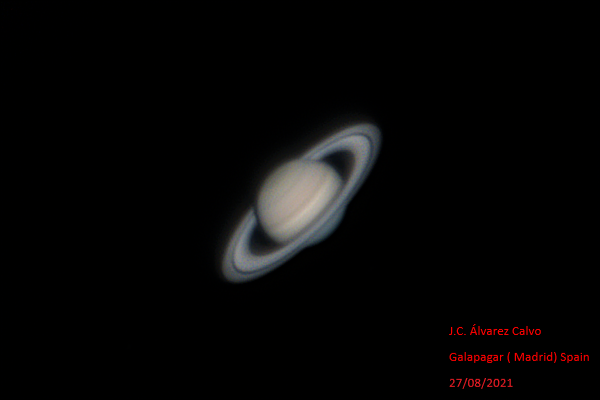 #  |
You cannot like this item. Reason: "ANONYMOUS".
You cannot remove your like from this item.
Editing a post is only allowed within 24 hours after creating it.
You cannot Like this post because the topic is closed.
Copy the URL below to share a direct link to this post.
This post cannot be edited using the classic forums editor.
To edit this post, please enable the "New forums experience" in your settings.











